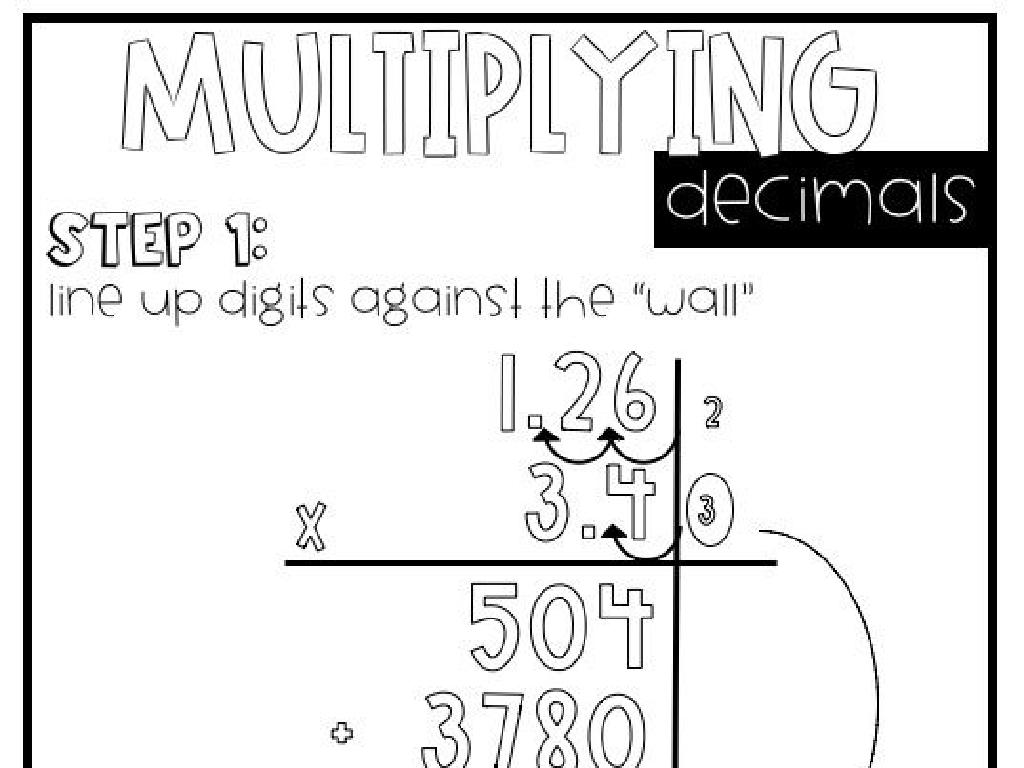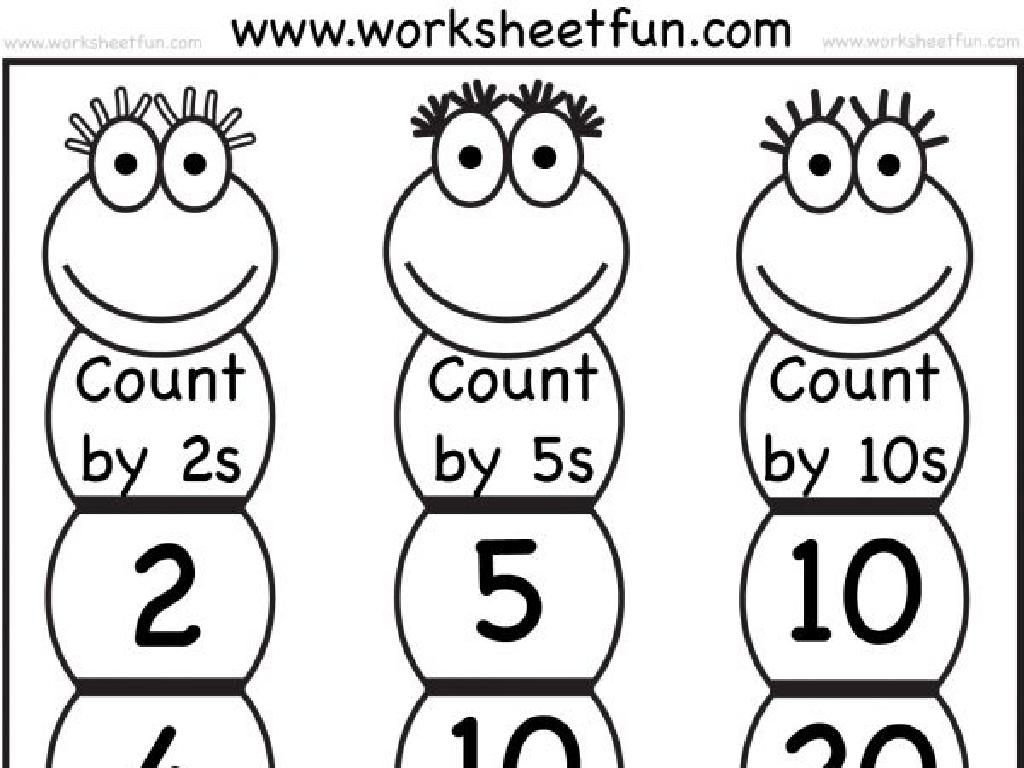Opposites Of Rational Numbers
Subject: Math
Grade: Sixth grade
Topic: Rational Numbers
Please LOG IN to download the presentation. Access is available to registered users only.
View More Content
Opposites of Rational Numbers
– Rational numbers overview
– Numbers that can be expressed as a fraction a/b, where a and b are integers and b is not zero.
– Recap: Defining rational numbers
– Rational numbers include integers, fractions, and decimals that can be positive or negative.
– Today’s focus: Opposites in math
– Opposites are numbers with the same magnitude but different signs, like 5 and -5.
– Exploring opposites with examples
– For example, the opposite of 3/4 is -3/4, and the opposite of -7 is 7.
|
This slide introduces the concept of opposites within the context of rational numbers. Begin by reviewing what rational numbers are, emphasizing that they include both positive and negative numbers, as well as zero. Explain that every rational number has an opposite, also known as its additive inverse, which is the same distance from zero on the number line but in the opposite direction. Use visual aids like a number line to demonstrate this concept. Encourage students to think of opposites as pairs of numbers that, when added together, equal zero. Provide several examples and ask students to come up with their own opposites of rational numbers.
Understanding Opposites in Rational Numbers
– Define opposite numbers
– Opposite numbers are the same distance from zero on a number line, but in opposite directions.
– Visualize opposites on a number line
– If 3 is on the right of zero, its opposite, -3, is on the left at the same distance.
– Find opposites of rational numbers
– To find the opposite, change the sign: the opposite of 5/7 is -5/7.
– Opposites in real-world scenarios
– Consider a debt (negative) and a credit (positive) of the same amount as opposites.
|
Begin by explaining that opposite numbers, also known as additive inverses, are two numbers that have the same absolute value but different signs, making them equal distance from zero on a number line but in opposite directions. Use a number line to visually demonstrate this concept with positive and negative integers, and then extend this understanding to rational numbers (fractions and decimals). Show how to find the opposite of a rational number by simply changing its sign. Finally, relate the concept to real-world scenarios, such as debts and credits in finances, to help students grasp the practical application of opposites. Encourage students to think of their own examples and to practice finding opposites of various rational numbers.
Properties of Opposites in Rational Numbers
– Opposites are additive inverses
– Two numbers are opposites if they are the same distance from 0 on the number line, but in different directions.
– Adding opposites results in zero
– For any number ‘a’, adding its opposite ‘-a’ will always equal 0 (a + (-a) = 0).
– Opposites in everyday life
– Temperatures above/below zero, gains/losses in points during a game.
– Understanding through examples
– If you have 5 apples and you owe 5 apples, you have 0 apples in total.
|
This slide introduces the concept of opposites, or additive inverses, in the context of rational numbers. It’s crucial to explain that opposites are two numbers that are the same distance away from zero on the number line but in opposite directions. Emphasize that when you add a number to its opposite, the sum is always zero. This is a fundamental property of opposites. Provide relatable examples such as temperature changes or scoring in games to illustrate the concept. Encourage students to think of their own examples of opposites and how they cancel each other out in real life. Use visual aids like a number line to demonstrate the concept clearly.
Finding Opposites of Rational Numbers
– Opposites have different signs
– Practice with fractions: 3/4, -7/2
– What are the opposites of 3/4 and -7/2?
– Zero: The unique opposite
– Zero is the only number that is its own opposite.
– Understanding opposites in equations
– Opposites in equations help balance and solve them.
|
This slide introduces the concept of finding opposites in rational numbers. Emphasize that the opposite of a number is simply the same number with the opposite sign. Provide practice examples with positive and negative fractions to solidify understanding. Highlight the special case of zero, which is the only number that is its own opposite, due to having no sign. Explain how understanding opposites is crucial in solving equations, as they help maintain balance. Encourage students to think of opposites as mirror images on the number line. During class, work through the practice examples together and discuss how changing the sign affects the value of a number.
Understanding Opposites of Rational Numbers
– Opposites in temperature
– Hot (e.g., 30°C) and cold (e.g., -30°C)
– Opposites in elevation
– Above sea level (+100m) and below sea level (-100m)
– Opposites in finance
– Profit ($20) and loss (-$20)
– Applying opposites concept
|
This slide aims to help students understand the concept of opposites in the context of rational numbers by relating it to real-world scenarios. Discuss temperature changes, explaining how numbers can represent hot and cold temperatures, with opposites being equal in magnitude but different in sign. For elevation, illustrate how heights above and below sea level are expressed with positive and negative numbers, respectively. In finance, show how profit and loss are opposite in nature, with profits being positive and losses negative. Encourage students to think of other examples where opposites apply and how they can be represented with positive and negative rational numbers. This will solidify their understanding of the concept and its practical applications.
Class Activity: Exploring Opposite Numbers
– Pair up and find opposite numbers
– Share your pairs with the class
– Discuss the concept of balance
– How do opposites help us in equations?
– Reflect on the importance of opposites
– Opposites can show us how things cancel out
|
In this interactive class activity, students will work in pairs to find and list pairs of opposite rational numbers. Encourage them to use number lines or counters if needed to visualize the concept. After finding opposites, each pair will share their findings with the class, fostering a collaborative learning environment. Lead a discussion on how understanding opposites can help us comprehend balance in mathematical equations and in real-life situations, such as financial transactions. This activity will help students grasp the concept that every number has an opposite, and when combined, they equal zero, demonstrating balance. Possible activities: 1) Use a number line to find opposites, 2) Find the opposite of a given set of rational numbers, 3) Apply opposites to simple algebraic equations, 4) Create a real-life scenario where opposites are used, 5) Use counters to demonstrate how opposites cancel each other out.
Practice: Opposites of Rational Numbers
– Find opposites of rational numbers
– If given 3/4, the opposite is -3/4
– Solve real-world problems
– E.g., temperature changes from +30°C to -30°C
– Discuss solutions as a class
– Share different methods used
– Understand application of opposites
– How opposites help in understanding debts and credits
|
This slide is aimed at reinforcing the concept of opposites in rational numbers through practice problems. Students will apply their knowledge to find the opposites of given rational numbers, which is simply changing the sign of the number. They will also solve problems that have real-world applications, such as temperature changes, to understand the concept better. Encourage students to discuss their solutions and methods during the class discussion, fostering a collaborative learning environment. Highlight the importance of understanding opposites in practical situations, such as financial literacy with debts (negative) and credits (positive). Prepare four to five varied practice problems for the students to solve and discuss.
Game Time: Opposite Match
– Engage in an interactive matching game
– Understand opposites of numbers
– Opposites are numbers with the same magnitude but different signs, like 5 and -5
– Collaborate in teams
– Find all opposite pairs
– Each team will match positive numbers with their negative counterparts
|
This interactive game is designed to reinforce the concept of opposites in rational numbers. Divide the class into small teams and provide each team with a set of number cards that include both positive and negative rational numbers. The goal is for students to match each positive number with its negative counterpart. This activity encourages teamwork and helps students to visually and practically understand that opposites are numbers that are the same distance from zero on the number line but in opposite directions. For example, +3 and -3 are opposites. Provide guidance and ensure that each team has a chance to discuss their strategy and findings. This game will help solidify their understanding of opposites in a fun and engaging way.
Wrapping Up: Opposites of Rational Numbers
– Recap of today’s lesson
– Key points on opposites
– Opposites are the same distance from zero on the number line, but in different directions.
– Time for questions and answers
– Reflect on what we’ve learned
– Think about how opposites of numbers can be used in real-life situations.
|
As we conclude today’s lesson on the opposites of rational numbers, it’s important to revisit the key concepts. Remind students that every rational number has an opposite, and these are located at the same distance from zero on the number line but in opposite directions. Encourage students to ask any lingering questions they might have during the Q&A session, ensuring they leave the class with a clear understanding. Finally, ask them to reflect on the importance of opposites in mathematical operations and how this concept might apply to real-world scenarios, such as debts and credits in finance or elevations below and above sea level in geography.
Homework: Mastering Opposites of Rational Numbers
– Complete the worksheet on opposites
– Find the opposite of each rational number
– Study adding and subtracting rationals
– Next class will focus on combining rationals
– Practice makes perfect
– Keep practicing, even if it’s challenging
– Tips for tackling rational numbers
– Use number lines and pair work for practice
|
This homework slide is designed to reinforce the concept of opposites in rational numbers and prepare students for the upcoming lesson on adding and subtracting rational numbers. The worksheet should include a variety of problems that require students to identify and write the opposite of given rational numbers. Encourage students to review their class notes and textbook examples to prepare for the next class. Remind them that consistent practice is key to understanding math concepts. Provide tips such as using a number line to visualize opposites and suggesting they work in pairs to discuss their answers. This collaborative approach can help clarify doubts and solidify their understanding.






